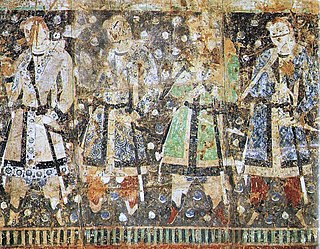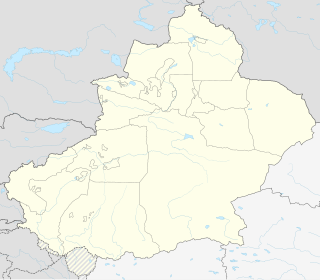Thousand Buddha Caves at Kizil
| Thousand Buddha Caves at Kizil
|
||
|---|---|---|
|
“ Tocharian donors”, with light hair and light color of eyes, 6th century fresco . |
||
| Location: | Bay County in Aksu Governorate in Xinjiang ( PR China ) | |
|
Geographic location: |
41 ° 46 ′ 55 " N , 82 ° 30 ′ 5" E | |
|
|
||
The Thousand Buddha Caves of Kizil , or Kizil Caves for short (also Qizil Caves ; Chinese 克孜尔 千佛洞 , Pinyin Kèzī'ěr Qiānfódòng or 克孜尔 石窟 , Kèzī'ěr shíkū ) are a series of 236 Buddhist Rock caves in Kizil Township (Qïzïl, 克孜尔 乡) of Bay ( Baicheng ) County in Aksu Governorate of Xinjiang Uyghur Autonomous Region , China .
location
The Kizil caves are located about 7 km southeast of Kizil on the northern bank of the Muzart River (Chinese: Muzate He ), about 75 km from Kuqa (Kutscha). The region was a trading center on the Silk Road .
history
The caves are one of the earliest significant Buddhist rock cave complexes in China. Most of the caves were dug in the period of the Southern and Northern Dynasties , the earliest as early as the 4th century (including the famous cave No. 38), the latest in the period of the Yuan Dynasty . Although the site was damaged and looted, many square meters of wall paintings - mostly with jatakas - have been preserved.
The cave temples have been on the list of monuments of the People's Republic of China in Xinjiang (1-41) since 1961 and have been part of the UNESCO World Heritage Site with the title Silk Roads: the road network of the Chang'an-Tianshan corridor since 2014 .
See also
literature
- Monika Zin : The Identification of Kizil Paintings I. In: Indo-Asiatische Zeitschrift , Volume 9, 2005, pp. 23-36
- Monika Zin: The Identification of Kizil Paintings II. In: Indo-Asiatische Zeitschrift , Volume 11, 2007, pp. 43–52
- Monika Zin: The Identification of Kizil Paintings III. In: Indo-Asiatische Zeitschrift, Volume 12, 2008, pp. 50-61
- Monika Zin: The Identification of Kizil Paintings IV. In: Indo-Asiatische Zeitschrift, Volume 14, 2010, pp. 22–30
- Monika Zin: The Identification of Kizil Paintings V. In: Indo-Asiatische Zeitschrift, Volume 15, 2011, pp. 57–69
- Monika Zin: The Identification of Kizil Paintings VI. In: Indo-Asiatische Zeitschrift, Volume 17, 2013, pp. 5–15
- Giuseppe Vignato: Kizil: Characteristics and Development of the Groups of Caves in Western Guxi. In: Annali dell′Istituto Universitrio Orientale di Napoli (AION), Volume 65, No. 1–4, 2005, pp. 121–140
Chinese literature
- Zhongguo shiku : Kezi'er shiku [Kizil Rock Caves], 3 vols., Beijing: Wenwu chubanshe 1984-85
- Cihai ("Sea of Words"); Shanghai: Shanghai cishu chubanshe 2002; ISBN 7-5326-0839-5
- Zhongguo da baike quanshu : Kaoguxue (Great Chinese Encyclopedia: Volume Archeology). Beijing: Zhongguo da baike quanshu chubanshe, 1986
Web links
- Kizil Thousand-Buddha Caves and Subashi Ruins. Travel China Guide
- Revealing the Beauty of the Kizil Caves. china.org.cn
Individual evidence
- ^ Silk Roads: the Routes Network of Chang'an-Tianshan Corridor. In: whc.unesco.org. UNESCO World Heritage Center, accessed February 7, 2019 .

